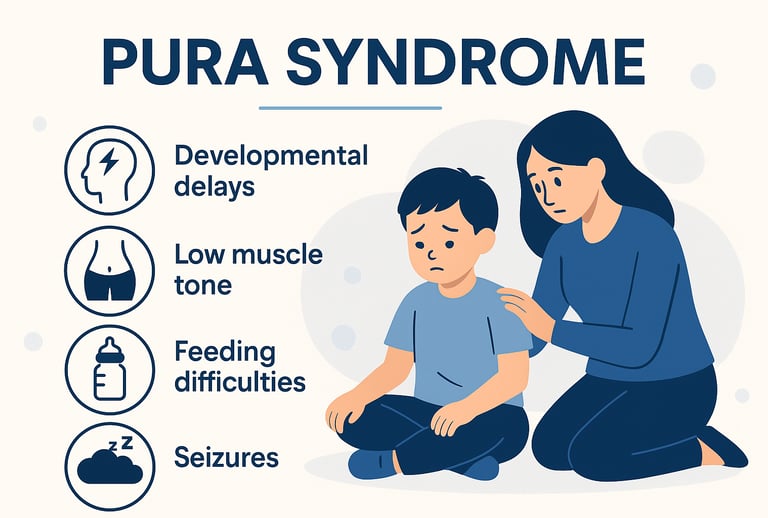Stay updated on what is trending in health. Discover tips and resources for a healthier, balanced life.
What Is PURA Syndrome? Understanding This Rare Genetic Condition
Discover what PURA Syndrome is, its signs and symptoms, and how early diagnosis and therapies can help. Learn how this rare genetic disorder affects development, movement, and learning.
DISEASES AND CONDITIONS
Dr. S. Ali
5/30/20253 min read


Have you ever heard of PURA Syndrome? If not, you're not alone—it's a rare genetic condition that affects only a small number of people worldwide. But for those families who live with it every day, understanding PURA Syndrome is incredibly important.
So, what exactly is PURA Syndrome?
PURA Syndrome is caused by a mutation in the PURA gene, which plays a key role in how the brain and nervous system develop. When this gene doesn’t work properly, it can lead to a range of symptoms that affect a person’s growth, learning, and movement.
Common Signs and Symptoms of PURA Syndrome
PURA Syndrome can show up in many different ways, and no two individuals are exactly alike. That’s one of the challenges—and realities—of this rare condition. However, some symptoms tend to appear more frequently in children diagnosed with PURA Syndrome. Here’s a closer look at what parents and caregivers might notice:
Developmental Delays
One of the earliest and most noticeable signs is a delay in reaching developmental milestones. This might include sitting up, crawling, walking, or talking later than expected. Speech and motor skills are often affected the most. Some children may not speak at all, while others develop a few words or phrases over time.
Low Muscle Tone (Hypotonia)
Many babies with PURA Syndrome have hypotonia, which means their muscles feel unusually floppy or weak. This can make it harder for them to hold up their heads, sit independently, or learn to walk. It also contributes to delays in motor development.
Feeding Difficulties
Feeding challenges are common in infancy. Babies may have trouble sucking, swallowing, or coordinating their movements to feed properly. This can lead to poor weight gain and the need for feeding support, such as special bottles or even feeding tubes in some cases.
Seizures and Abnormal Brain Activity
Seizures can occur in some children with PURA Syndrome, although not all experience them. Even without visible seizures, EEG (electroencephalogram) tests may show irregular brain activity. These neurological changes can affect attention, sleep, and learning.
Sleep Disturbances
Parents often report that their children have trouble falling or staying asleep. Some may wake frequently during the night, nap irregularly, or appear overly sleepy during the day. These sleep disruptions can impact both the child’s development and the caregiver’s well-being.
Learning Challenges
As children grow, they may face cognitive delays or intellectual disabilities. Some may require special education services, while others might learn at a slower pace but continue to make steady progress with the right support.
Movement and Balance Issues
Because of low muscle tone and delayed motor skills, walking may be difficult for some children. They might need assistive devices like walkers or braces, and they may struggle with coordination or balance.
A Spectrum of Symptoms
It’s important to remember that PURA Syndrome is a spectrum disorder, meaning that symptoms can range from mild to severe. Some children may eventually walk and talk with support, while others may need lifelong care and therapy.
Professional Tip: Early diagnosis and intervention with therapies—such as physical, occupational, and speech therapy—can greatly improve outcomes and quality of life.
How Is It Diagnosed?
PURA Syndrome is usually diagnosed through genetic testing. If a child shows unexplained developmental delays or muscle weakness, a doctor might recommend a genetic panel to check for conditions like PURA. A diagnosis can help families better understand what’s going on—and what to expect.
Is There a Cure?
Unfortunately, there’s currently no cure for PURA Syndrome. But the good news is that early intervention can make a big difference. Therapies like physical, occupational, and speech therapy can help children build strength and improve communication. Some may also need medication to manage seizures or sleep issues.
Living with PURA Syndrome
Raising a child with PURA Syndrome can come with unique challenges, but support is out there. Many families find comfort and guidance in online communities and foundations dedicated to rare genetic conditions.
Professional Tip: If you're a parent or caregiver, keeping a health journal can help track your child’s progress and identify patterns. It can also be helpful when talking to doctors and therapists. While any notebook can work as a health journal, a dedicated health journal designed for tracking symptoms, therapies, milestones, and medications is often more effective—especially for a condition like PURA Syndrome.
You can get to print a free copy of the journal here.
Why It Matters:
When managing a rare condition like PURA Syndrome, patterns might be subtle or spread out over weeks. A structured journal helps spot these trends, track what therapies are helping, and make medical visits more productive.
Final Thoughts
PURA Syndrome may be rare, but awareness is growing. By sharing information, supporting research, and connecting families, we can make a real difference in the lives of those affected.
If you found this article helpful, consider sharing it with others. Every bit of awareness helps!
Sources:
PURA Syndrome Foundation – PURA 101
https://purasyndrome.org/understanding-pura-syndrome/pura-101/
Cleveland Clinic – PURA Syndrome Overview
https://my.clevelandclinic.org/health/diseases/24151-pura-syndrome
MedlinePlus Genetics – PURA Syndrome
https://medlineplus.gov/genetics/condition/pura-syndrome/
NCBI / PubMed Central (U.S. National Institutes of Health)
https://www.ncbi.nlm.nih.gov/pmc/articles/PMC5821266/
MDPI - Genes Journal
https://www.mdpi.com/2073-4425/15/7/848
Frontiers in Pediatrics
https://www.frontiersin.org/articles/10.3389/fped.2024.1323014/full
Pulse Your Health
Empowering you to achieve your health goals.
Contact
© 2025. All rights reserved.
Disclaimer: The content on this website is for informational purposes only and is not medical advice. Always seek the advice of your physician or other suitably qualified healthcare professional for diagnosis, treatment and your health related needs.
